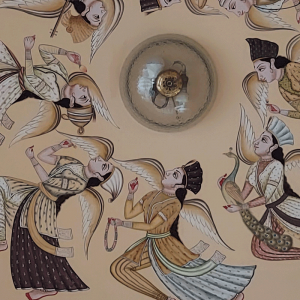Cultural history of hair oiling
Blog › Hair › Cultural history of hair oiling

How to integrate the age old tradition into your self care routine:
In the ancient Indian language Sanskrit, the word oiling “sneha” also means to love. This is a beautiful explanation of the timeless tradition of hair oiling, which is often passed down through generations by mothers to her children.
In Ayurveda, the ancient Indian system of health, different oils are used on the body and hair depending on a persons individual needs, as well as the season. This is because it is believed that different ingredients have different properties; for example, sesame seed oil is used more in winter as it has a warming effect, while coconut oil is used in summer for its cooling effect. Not only are different combinations of oils used, different herbs are also infused with the oil to add fragrance and health boosting benefits.
Ayurvedic Hair Ingredients: Unlocking the Secrets of Healthy Hair
In a world where hair care products seem to be constantly evolving, there’s a timeless and natural approach to maintaining healthy hair – Ayurveda. Ayurvedic hair ingredients have been trusted for centuries to promote hair health and vitality. Let’s delve into the benefits of some key Ayurvedic ingredients and how they’re used:
1. Bhringraj (Eclipta prostrata):
Antimicrobial Properties: Bhringraj is renowned for its antimicrobial properties, making it an excellent choice for preventing scalp infections and maintaining a healthy scalp environment.
Hair Health: It nourishes the hair follicles, promoting hair growth and preventing hair fall. Bhringraj oil is a popular way to harness its benefits, as a regular scalp massage can stimulate hair growth.
2. Amla (Indian Gooseberry):
Hair Growth: Amla is a potent source of vitamin C, which aids in collagen production. Collagen strengthens hair and promotes growth.
Antioxidants & Vitamin E: Its high antioxidant content protects hair from damage and oxidative stress, while vitamin E nourishes and adds shine.
Usage: Amla can be used in hair masks, oils, or shampoos to improve hair texture and health.
3. Shikakai (Acacia concinna):
Dandruff Control: Shikakai’s natural cleansing properties help rid the scalp of excess oils and dandruff, leaving it clean and itch-free.
Strengthens Hair: It strengthens hair roots and prevents breakage, making it an essential ingredient in many Ayurvedic hair care routines.
4. Hibiscus (Rosa sinensis):
Hair Growth: Hibiscus flowers and leaves are rich in vitamin C and amino acids that stimulate hair growth by increasing blood circulation to the scalp.
Vitamin C: It nourishes hair follicles and prevents premature graying.
Usage: Hibiscus can be used in hair oils, masks, or as a rinse to enjoy its benefits.
5. Rosemary (Rosmarinus officinalis):
Improved Circulation: Rosemary promotes blood circulation in the scalp, which is crucial for hair growth.
Hair Growth: Its essential oil is known to encourage hair growth and reduce hair loss.
Soothing: Rosemary has a calming effect on the scalp, reducing irritation and dandruff.
6. Henna (Lawsonia inermis):
Hair Growth: Henna strengthens the hair shaft and promotes hair growth while adding natural color and shine.
Shine: Colourless henna is used to enhance hair’s shine without the red tint.
Usage: Henna is often mixed with other ingredients like amla and yogurt for a nourishing hair mask.
7. Neem (Azadirachta indica):
Anti-Inflammatory & Anti-Bacterial: Neem combats scalp infections and inflammation while preventing dandruff.
Usage: Neem oil or neem leaves can be used in hair masks and shampoos for a soothing and cleansing effect.
Incorporating these Ayurvedic hair ingredients into your hair care routine can result in stronger, healthier, and more vibrant hair. Whether you’re aiming to combat hair loss, dandruff, or simply want to boost your hair’s natural shine and strength, these time-tested remedies offer a holistic and natural approach to hair care that has stood the test of time.
Hair oiling & self care
Hair oiling as a practice has been a part of many cultures throughout history. In ancient India, the use of hair oil was considered an important part of daily grooming. It was believed to promote hair growth and help keep the scalp healthy. Different oils were used for different hair types and concerns. In Ayurvedic medicine, regular hair oiling was said to prevent headaches, hair loss, greying of hair as well as helping with better sleep and happiness as it improved circulation.
In ancient Egypt, hair oil was used not just for grooming, but also as a sign of social status. Wealthy Egyptians would use fragrant oils to perfume their hair and keep it healthy. The use of hair oil was also common in ancient Greece and Rome, where olive oil was a popular choice.
In many African cultures, hair oiling was an important part of hair care. Oils such as shea butter and castor oil were used to moisturize and protect the hair. In some cultures, hair oiling was also used as a way to bond with family members. Mothers would oil their daughters’ hair as a way of showing love and care.
Today, the practice of hair oiling continues in many cultures around the world. While the specific oils and techniques may vary, the benefits of hair oiling are still believed to include promoting healthy hair growth, preventing breakage, and keeping the scalp moisturised and healthy, and of course as part of a self care routine.